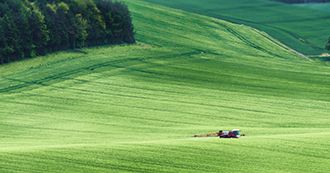
Welcome to this quarter’s Farming Update, which is produced by our Farming Research Group and reports on market and administrative issues that affect farmers’ business decisions and on which they may need to act.

The most significant development this spring has been the launch of the much anticipated consultation document on the future of farming policy from DEFRA. This followed two speeches from the Secretary of State, Michael Gove, at the Oxford Farming Conference and then the NFU Conference, in which he gave hints as to the direction of travel. We can now be certain that direct payments will be capped heavily in the short term and then phased out in the years after Brexit. Although it is stated that farmers will be rewarded for providing ‘public goods’, we remain very short of any detail about how these goods will be valued and how farmers will be able to secure the funding. Meanwhile, out in the field the widespread cold weather and snow in early March has held up spring drilling but, in general, winter crops have come out of the winter looking well and full of potential.
Arable crops
Global
Markets received renewed reassurance as to the world’s stock levels with the publication in early February of the UN’s FAO (Food and Agriculture Organisation) latest Supply and Demand briefing. “Global markets of all major cereals remain well balanced, supported by record inventory levels,” according to the report. It reports that the world’s stocks-to-use ratio is likely this season to reach its highest level since 2001/2. Of some comfort to UK cereal growers will be the fact that much of the increased estimates for grain production are due to increases in coarse grains (as opposed to wheat), with higher maize production in China, & Mexico. Nevertheless, expectations of big wheat harvests in Canada and Russia have increased the wheat production estimates to 757.6 million tonnes (2.8mt higher than the previous estimate). The outlook for global prices in the short term is therefore relatively bearish, because even with the increase in expected cereal usage for 2017/2018, which is now 2.6 billion tonnes (up 35.7 million tonnes from 2016/17), the stocks-to-use ratio of cereals will rise to a “comfortable 27.7%, the highest level since 2001/02”.
UK
Against the global backdrop of surplus, the UK has a much tighter supply and demand profile; at the end of 2017, DEFRA cut its 2017 wheat harvest estimate by 320,000T to 14.84 million tonnes. This has helped to support the domestic feed grain market as it substantially reduces the amount of wheat that the UK has available to export this season. Prices of cereals have not moved a great deal since harvest, and only feed barley has shown any real increase since September: £118/T compared with over £130/T in early March.
The physical markets are only part of the story however, and fluctuations are also driven by currency. As the Prime Minister embarks on further rounds of Brexit negotiations with the EU, the value of sterling will follow her fortunes: farmers may be hoping for it to weaken in order to support domestic values.
Oilseed rape prices tumbled in the last three months to around £290/T ex farm, before recovering slightly, but remaining stubbornly below £300/T. According to AHDB, much of this is currency driven, as the Euro strengthened against the US dollar (which caused prices to fall on the Paris rapeseed futures market, resulting in falls in the UK price) and in turn sterling strengthened against the Euro. UK prices are also being heavily influenced by world events, and recent rain in Argentina – easing fears of drought issues on the soya bean crop – have also sent prices lower. Farmers are not selling at current prices, and so crushers are using up their stocks. It would seem that currency will need to work in farmers’ favour again, if prices are to recover before farm stores need to be cleared out in June.
2018 Crops
The New Year started with concerns that the mild wet weather was affecting the residual herbicide activity in the rape but, by the end of January, the blackgrass sprays had begun to take effect. Charlock is slowly dying following treatment, and only the most stubborn areas require a possible follow up treatment.
In rape crops, now is the time to continue patrols to scare pigeons away so that there is some top growth to help keep the growing point away from cabbage stem flea beetle larvae damage; our agronomists’ assessments indicate that the number of larvae is generally not as high as previously seen which we hope will result in fewer losses.
In general, crops look well, although poor drainage and insufficient rooting is affecting some rape crops, giving the plants a purple-blue appearance. Wheat appears to be thriving – in some places further ahead than it should be for the time of year. Blackgrass control in cereals is not as good as last year, but better than winter 2015/16 – with more grass having germinated in the drilling period due to weather and soil conditions.
Late planted winter crops and spring crops are less tolerant of weather extremes. Doing everything you can to ensure a good root base – be that early nutrition or in cultivations – will add to a crop’s robustness, and will reduce yield variability.
On farm, spring seed should by now have been dressed. Some spring barley was sown into light land before the very cold and snowy spell in the first few days of March. Soils are currently lying wet in most areas, so patience may be tested for those with a large area of spring crops to drill. This waiting time may provide a window to sit down with the team to appraise last year’s harvest in detail. Analysing the yield maps is a good start, and cultivations, seed rates, drilling date, agronomy and harvesting can all be discussed to see where potential improvements can be made.
Most clients now have some 2018-crop sales on their books, with the most reliable malting barley growers securing forward contracts at £150/T or above for autumn movement; however for many it is too risky to commit to producing malting specification, particularly after the difficulties seen in 2017. Feed wheat sales have been booked in the region of £140/T.
